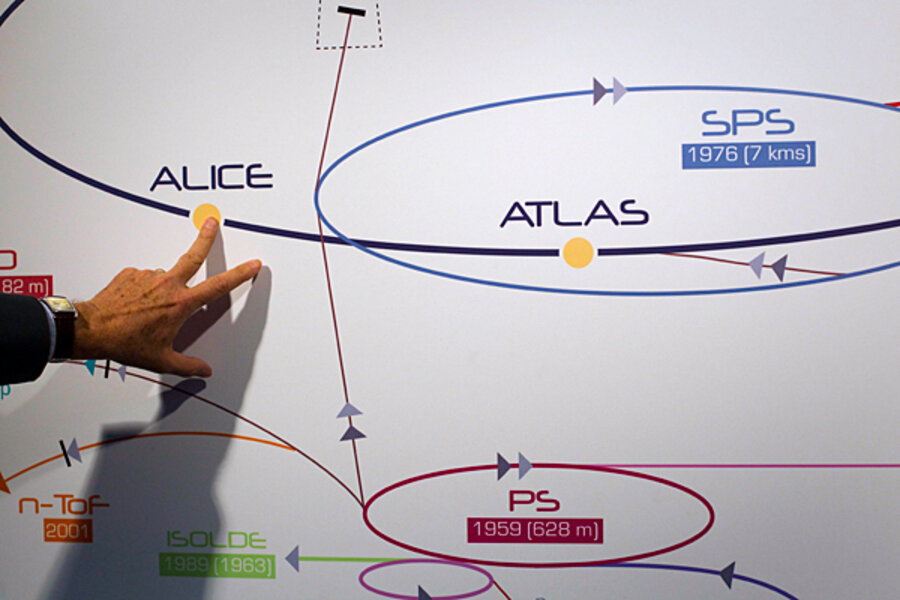Will scientists announce discovery of Higgs boson? Buzz is building.
Loading...
The buzz is building as physicists prepare to present the latest results in their hunt for the Higgs particle – the key to answering the question: Why does matter have mass?
The definitive statement about what scientists involved in two major experiments at European Organization for Nuclear Research (CERN) in Geneva have found and their levels of confidence in the results comes early Wednesday morning. But one blog that has developed a reputation for reliable – if unofficial – analysis of forthcoming research has already predicted that scientists have found the long-sought particle.
In his blog, viXra Log, independent British physicist Philip Gibbs combined data from the two experiments at CERN as well as two experiments at the Fermi National Accelerator Laboratory in Batavia, Ill. His analysis "favors" the presence of some sort of Higgs particle.
The discovery of the Higgs particle would be momentous because it would vindicate scientists who theorized that its existence would explain a core mystery of physics. Three independent groups of physicists first proposed it in the 1960s to explain why fundamental particles – the most basic building blocks of matter – had enormous differences in mass.
In particular, wondered why electrons, which whiz around the nucleus of an atom, are ultralight, while quarks, which make up the protons and neutrons in the nucleus, are heavier.
The theorists' proposed answer was that the universe is permeated by a universal field that gives particles mass. The amount of mass a particle takes on, then, depends on how strongly it interacts with this field, called the Higgs field.
But how would anyone know such a field exists? In quantum physics, fields have subatomic particles associated with them – detected or hypothesized. The electromagnetic field has the photon, for instance. The Higgs field is predicted to have the Higgs boson.
Without Higgs, the so-called Standard Model of physics is incomplete. The Standard Model describes the properties of the 16 particles – including quarks and electrons – that form the fundamental building blocks of the universe. It also explains three of the four forces that govern their interactions – the strong force (which binds particles that make up atomic nuclei), the weak force (which governs radioactive decay), and electromagnetism. Gravity is the only force yet to be explained by the Standard Model.
The discovery of the Higgs boson would be exciting, because it would fill one of these remaining gaps, says Meenakshi Narain, a researcher at Brown University in Providence, R.I., and a member of one of the two teams at CERN that will report its results. But, she adds, merely saying it's found would not answer the really interesting questions.
If the Higgs boson exists, Dr. Narain says, she wants to know how it decays.
Theories suggest Higgs can exist only at the very high energies that existed right after the Big Bang, the enormous release of energy that physicists credit for giving rise to the universe some 13.6 billion years ago. In fact, Higgs could have existed naturally only during the first millionth of a millionth of a second after the Big Bang. Then, it would have decayed into other particles as the universe cooled.
CERN's Large Hadron Collider can accelerate two beams of protons to nearly the speed of light before steering them into head-on collisions that generate energies comparable to those earliest fractions of a second after the Big Bang. Detectors pick up the signatures of a shower of particles the collisions create, including particles that are the lower-energy byproducts of a Higgs boson's decay. By analyzing the debris, researchers can work backward to determine the types of particles that created it – the approach they are using to identify the Higgs boson.
Currently, theories predict that the Higgs boson decays along five different paths at the same time, each producing its own unique mix of lower-energy particles. Each of the five blends of decay particles is thought to be present in specific proportions. But if any one of those proportions is off by a significant amount, it would send theorists back to the chalkboard, Narain explains.
"That's when, as a physicist, it gets really exciting," she says.
Indeed, blogger Dr. Gibbs's analysis yielded an odd outcome for one of these paths. He noted that the oddity could result from errors in the original measurements or in the approaches the various teams used to figure out ahead of time what a Higgs signature in the debris might look like.
Teasing out the information on decay paths requires more data than the CERN teams have amassed so far, Narain adds.
But turning up the unexpected is something "I would very much like to happen," she says. "If we find it, I hope is is something non-standard."





